The common starling (Sturnus vulgaris), also known as the European starling, is one of the world’s most adaptable and widespread passerines. Native to Europe, western Asia, and North Africa, it has been introduced to North America, Australia, New Zealand, and elsewhere, where it has firmly established itself. Known for its dark iridescent plumage, speckled appearance in non-breeding season, and extraordinary vocal mimicry, the starling is a highly social species frequently seen in large flocks across farmland, cities, and suburbs.
Though abundant, its populations have shown notable regional declines in parts of Europe and North America, largely linked to agricultural intensification. Celebrated for its aerial murmurations and behavioral flexibility, yet controversial as an invasive species, the common starling remains a focus of both scientific study and conservation debate. This report explores its biology, behavior, global distribution, and the challenges that lie ahead for this complex and resilient bird.
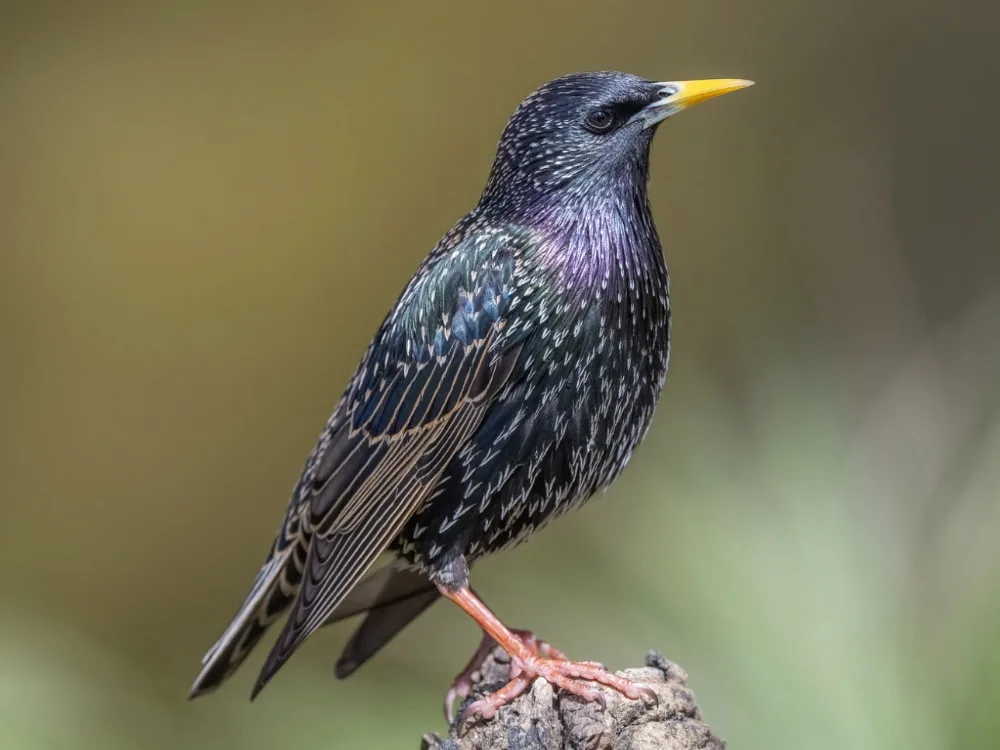
| Common name | Common starling |
| Scientific name | Sturnus vulgaris |
| Alternative names | Starling, European starling |
| Order | Passeriformes |
| Family | Sturnidae |
| Genus | Sturnus |
| Discovery | Described by C. Linnaeus in 1758; part of a diverse Old World starling lineage |
| Identification | Medium-sized passerine with dark iridescent plumage, pale speckles in non-breeding season, and a long slender bill; known for chattering vocalizations and mimicry |
| Range | Native to Europe, western Asia, and North Africa; introduced populations established in North America, Argentina, Australia, New Zealand, and South Africa |
| Migration | Partially migratory; northern and eastern populations migrate south in winter, while southern and urban populations tend to be resident |
| Habitat | Occupies a wide range of habitats including farmland, urban areas, grasslands, and coastal cliffs; avoids dense forests and deserts |
| Behavior | Highly social and adaptable; forms large flocks and murmurations; aggressive at nest sites; known for mimicry and social learning |
| Lifespan | Typically 2-3 years in the wild; oldest confirmed individual reached 22 years and 11 months |
| Diet | Omnivorous; feeds on insects, earthworms, fruits, grains, seeds, and food waste; uses specialized probing and bill-gaping technique |
| Conservation status | Least Concern (IUCN) |
| Population | 250-300 million individuals globally, over half found in Europe; North American population exceeds 150 million |
Discovery
Long before its formal scientific description, the common starling was a familiar and well-recognized bird across Europe. Its noisy flocks, striking plumage, and remarkable vocal mimicry made it prominent in rural and urban folklore, literature, and daily life. The bird was known in Old English as staer, later stare, a term that persisted in English vernacular into the early modern period and is still referenced in poetry, such as William Butler Yeats’ “The Stare’s Nest by My Window.”
The species was first scientifically described by Carl Linnaeus in the 10th edition of Systema Naturae (1758), under the binomial name Sturnus vulgaris. Both the genus name Sturnus and the species epithet vulgaris are Latin in origin, translating to “starling” and “common,” respectively. Linnaeus’ naming reflected the bird’s wide distribution and abundance across its native range. This nomenclature has remained unchanged, and the species continues to be recognized under the same scientific name today.
Subsequent taxonomic work placed Sturnus vulgaris within the starling family (Sturnidae), a group confined to the Old World apart from introductions. Molecular studies in recent decades have revealed that the genus Sturnus is polyphyletic, and relationships within the group remain incompletely resolved. Genetic data suggest a particularly close relationship between the common starling and the non-migratory spotless starling (Sturnus unicolor), which may have diverged from a refugial population of S. vulgaris in the Iberian Peninsula during Pleistocene glaciations.
Interestingly, mitochondrial DNA evidence has shown greater genetic divergence between different populations of S. vulgaris than between S. vulgaris and S. unicolor, raising the possibility that the latter may represent a subspecies rather than a distinct species.
Modern subspecies of the common starling are primarily distinguished by subtle differences in size and plumage tone across geographic gradients. Roughly a dozen subspecies are currently recognized, though their status varies among authorities due to widespread intergradation. Over time, several historical subspecies designations have been synonymized, as further study revealed them to be hybrid forms or geographically intermediate populations rather than true genetic lineages.
Identification
The common starling is a medium-sized passerine, measuring between 19 and 23 centimeters (7.5-9.1 inches) in body length, with a wingspan of 31 to 44 centimeters (12-17 inches). Adults typically weigh between 58 and 101 grams (2.0-3.6 ounces), though most fall near the middle of this range. The species has a compact, round-bellied build, with a relatively short tail measuring 5.8 to 6.8 centimeters (2.3-2.7 inches) and a sharp, blade-like bill measuring 2.5 to 3.2 centimeters (0.98-1.26 inches).

Adult plumage is highly iridescent, appearing black at a distance but shimmering with purple and green gloss in good light. In fresh winter plumage, the body is densely spangled with white or buff-colored tips on the breast and back feathers, giving a speckled appearance. These tips gradually wear away by the breeding season, leaving the bird with a more uniformly glossy appearance. Molt occurs annually in late summer, following the breeding period.
There is some degree of sexual dimorphism. Males generally have fewer breast spots than females at the same time of year and possess longer, looser throat feathers, which are used in display. Females tend to have sharper, more pointed throat feathers. During the breeding season, males have bright yellow bills with bluish-grey bases, while females display lemon yellow bills with pinkish bases. In winter, both sexes have darker, brownish-black bills. Another reliable sexing trait is iris color: males usually show a rich brown iris, while females have a mouse-brown or grey iris, a difference that can be used with high accuracy in combination with throat feather length.
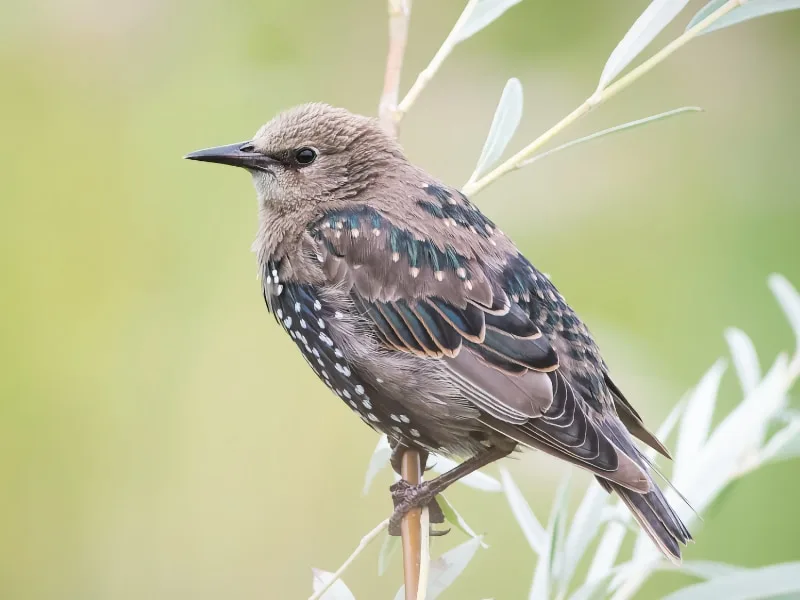
Juveniles are distinctively different from adults. They are pale brown overall, lacking iridescence and white spotting, and have a dark bill. As the first winter approaches, juveniles undergo a partial molt, gradually acquiring adult-like plumage, though some brown juvenile feathers may remain, especially on the head and neck. By the end of their first winter, most are visually indistinguishable from adults.
In flight, starlings are recognizable by their short, pointed wings, creating a distinctive star-shaped profile that inspired their English name. On the ground, they move with a slightly waddling gait and stand out due to their stout reddish legs and compact frame.
Subspecies
The common starling is currently divided into around a dozen recognized subspecies, which show gradual geographic variation in size, plumage gloss, and spotting. These differences are largely clinal, meaning they shift gradually across the species’ broad range, and many forms intergrade in contact zones.
The nominate subspecies (Sturnus vulgaris vulgaris) occupies most of Europe and has been introduced to several other regions, including North America, Iceland, and the Canary Islands. Island subspecies such as S. v. faroensis (Faroe Islands) and S. v. zetlandicus (Shetland Islands) tend to be larger and darker, with reduced spotting in fresh plumage. By contrast, S. v. granti from the Azores, Portugal is smaller, with strong purple gloss.
Eastern subspecies such as S. v. poltaratskyi, S. v. tauricus, and S. v. purpurascens differ mainly in wing gloss and body coloration, while Central and South Asian forms, including S. v. porphyrorrhous, S. v. nobilior, and S. v. humii, are generally smaller with more localized feather gloss patterns. Some populations, such as S. v. minor in Pakistan, show strong green gloss on the head and back, with reduced spotting.
Vocalizations
The common starling is a highly vocal species with a complex and diverse vocal repertoire that includes whistles, rattles, trills, warbles, and imitations. Males are the primary singers and produce elaborate song bouts that often exceed one minute in duration. These bouts are structurally organized into four sequential sections: they typically begin with pure-tone whistles, followed by a highly variable segment that may include mimicry of other birds or environmental sounds, then transition into repetitive rattling sequences, and end with bursts of high-frequency notes. Individual males may possess song repertoires exceeding 40 distinct types, and older birds tend to have both longer song bouts and more extensive repertoires than younger ones.
Listen to the common starling calls:
Song complexity plays a key role in sexual selection. Field experiments have shown that females prefer males with longer, more varied songs, independent of territory quality or morphology. Males with more elaborate songs tend to attract mates earlier and have higher reproductive success. Song learning continues after the first year, but the ability to acquire new song types appears to decline with age, indicating that while the species is an open-ended learner, repertoire expansion is most pronounced in younger males.
Starlings are also exceptional mimics, able to reproduce the calls of numerous other bird species as well as anthropogenic (human-generated) sounds – a trait commonly found in some of the most cognitively advanced birds. Mimicked elements are often integrated fluidly into a bird’s own song structure. Some individuals have been recorded mimicking a sound after hearing it only once. Mimicry is not random: males tend to incorporate structurally simple, recognizable sounds, and repeat each phrase several times before moving on to the next.
In addition to song, the species uses a range of calls for social coordination, aggression, alarm, and contact. These include purr-like sounds during takeoff, rattling chatter when joining flocks, and high-pitched trills or screams during aggressive encounters. Both sexes produce these calls, and at least 10 distinct types have been identified. While foraging or roosting in groups, starlings vocalize almost constantly, leading to a characteristic background of chatter. During synchronized flight, large flocks also generate an audible “whooshing” from wingbeats.
Listen to the starling flock calls:
Although males are more frequent singers, females also sing, particularly outside the breeding season. Song continues throughout most of the year except during molt. The function of non-breeding season song remains unclear, though it may play a role in social cohesion or vocal practice.
Neurologically, male starlings possess a syrinx approximately 35% larger than that of females, contributing to their superior vocal range. Song production is influenced by hormonal status and social context: males with access to nest sites or high social dominance show elevated rates of singing, even in the absence of increased circulating testosterone. Specific brain regions associated with song learning and motor control, such as the robust nucleus of the arcopallium (RA), show structural plasticity in response to acoustic competition, suggesting that vocal interaction shapes neural architecture.
Finally, starlings are capable of individual vocal recognition, distinguishing between familiar individuals based on song structure, order of song types, and specific spectral features. This ability is likely important for mate recognition and social interaction within flocks.
Range
The common starling has one of the most extensive distributions among passerines. Native to temperate Eurasia, it breeds across Europe, the Middle East, Central Asia, and parts of Siberia and western Mongolia. Through deliberate human introductions, the starling has established large, self-sustaining populations on five continents. It is now widespread across North America, New Zealand, southeastern Australia, South Africa, and localized parts of South America and the Caribbean.

In North America, a single introduction of around 60 birds in New York’s Central Park in 1890 led to explosive expansion, with the population now estimated at over 150 million individuals, ranging from southern Canada to Central America. In Australia and New Zealand, the species was introduced to control agricultural pests and rapidly colonized vast areas. Similar expansion patterns have occurred in South Africa, where the species thrives in irrigated and anthropogenic landscapes, and in parts of Argentina, where it continues to expand along the Atlantic coast.
Migration
Migration in the common starling is facultative and varies widely by region. Birds in southern and western Europe and urban areas tend to be resident year-round, while those from northern and eastern Europe, Russia, and central Asia migrate seasonally to escape cold winters and limited food availability.
European migrants travel to Iberia, North Africa, the eastern Mediterranean, and as far as the Indian subcontinent. Some birds reach Iran, Iraq, and occasionally Hong Kong or Japan. Ringing studies in Britain have documented movements between the UK and as far afield as Finland, Russia, Poland, and Germany, with numerous migratory streams crossing the continent in autumn. In North America, birds from Canada migrate southward, wintering in the southwestern United States, Mexico, and the Lesser Antilles.
Tracking studies in Europe have revealed complex migratory behaviors, including molt-migration, where some individuals depart the breeding grounds shortly after fledging to molt at staging sites hundreds of kilometers away. Others remain near their nesting area until late autumn. Birds undertaking molt-migration tend to arrive later at breeding grounds the following spring and show higher energetic investment during the pre-breeding period.
Although once thought to be diurnal migrants, new geolocation data show that up to 67% of migratory flights occur at night, sometimes reaching altitudes of 2,500 meters (8,200 feet) and lasting over 22 hours. These findings highlight the species’ behavioral flexibility and the varied strategies it employs to navigate seasonal resource shifts across its vast range.
Habitat
A key factor in the starling’s global success is its broad ecological flexibility. In both native and introduced ranges, it thrives in open or semi-open habitats with scattered trees or structures for nesting. Typical environments include farmland, urban parks, pastures, orchards, golf courses, and suburban neighborhoods, where short vegetation and human activity provide ample foraging opportunities. The species avoids dense forests, deserts, and high-altitude scrub without access to cavities.
During the breeding season, starlings favor sites with access to cavity nests – in trees, cliffs, buildings, or artificial nest boxes – close to open grassy areas for insect foraging. In the non-breeding season, they expand into a wide range of environments, including coastlines, wetlands, reedbeds, rubbish tips, and even sewage treatment plants. Roosts can number in the thousands and are often located in reedbeds, dense shrubs, city buildings, or under bridges.
In mountainous regions, the species has been recorded up to 1,900 meters (6,200 feet) above sea level, and in coastal zones, it frequently forages along the shore among seaweed and drift debris. This environmental versatility, paired with its social behavior and generalist diet, allows the common starling to adapt rapidly to novel landscapes, making it both a biological success and, in many regions, an ecological concern.
Behavior
The common starling is a highly social and adaptable bird with behavior shaped by its gregarious nature, advanced vocal and visual communication, and strong association with human-modified landscapes. While often celebrated for its murmurations and mimicry, the species also displays complex dominance hierarchies, strong intraspecific cohesion, and aggressive interspecific interactions, especially in competition for nesting cavities. It is a bird of contrasts, both admired and reviled, depending on its role in local ecosystems.
Social behavior and movement
Starlings are intensely gregarious, especially outside the breeding season. They form flocks ranging from a few dozen to over a million individuals, most famously in swirling aerial formations known as murmurations. These dense, synchronized flocks may serve multiple functions: evading predators, sharing foraging information, or simply navigating roosting grounds. Each bird adjusts its speed and direction based on its nearest neighbors, resulting in fluid collective movement without centralized control.

Flight is strong and direct, with rapid wingbeats and occasional short glides. During migration, individuals have been recorded flying at 60-80 km/h (37-50 mph) and covering up to 1,500 kilometers (930 miles) in a single season. On the ground, starlings move by walking or running rather than hopping. Their feeding technique, known as open-bill probing, is supported by specialized jaw and skull musculature that allows them to insert their bill into the soil and force it open to expose buried prey.
Communication among starlings is rich in both sound and posture. Agitated individuals may flick wings, puff feathers, or stare at rivals, while submissive birds crouch or retreat. Fights may involve stabbing with the bill or displacing each other from perches. Despite their aggression, starlings also frequently forage in mixed-species flocks, often associating with blackbirds, grackles, robins, sparrows, and crows.
Predators and parasites
While agile in the air, starlings are preyed upon by a wide range of avian predators, particularly falcons such as the peregrine falcon (Falco peregrinus), merlin (Falco columbarius), and Eurasian hobby (Falco subbuteo), as well as sparrowhawks and other accipiters. Owls, particularly barn, tawny, and eagle owls, pose a threat to roosting flocks at night. Juveniles are more vulnerable to slower but persistent raptors like buzzards or harriers, and ground predators such as cats, squirrels, mustelids, and raccoons may raid nests.
Parasitism is extensive. Surveys in North America found that virtually all individuals carry parasites, with nearly 100% hosting external mites, fleas, or ticks, and over 90% carrying internal parasites such as worms. Common arthropods include hen fleas, chewing lice, and feather mites, while dangerous internal parasites include the gapeworm, which can cause suffocation, and spiny-headed worms affecting the intestines. Protozoan blood parasites such as Haemoproteus are also present.
While starlings are occasionally targeted by nest invaders such as the lesser honeyguide (Indicator minor) in Africa or aggressive species like common mynas (Acridotheres tristis), they more commonly play the role of aggressor. As dominant cavity nesters, starlings frequently displace other birds from nest sites, but competition and reproductive interference also occur within the species itself.
Brood parasitism
While starlings are not known for parasitizing other species’ nests like true brood parasites, intraspecific egg-laying within conspecific nests is well documented in the common starling. Multiple studies across Europe and North America have found that 11-37% of first clutches may be parasitized in a given year, even in colonies where nestboxes were abundant. Most parasitic events involve a single egg, laid during the host’s laying period, particularly in early-season nests when reproductive value is highest. In many cases, a host egg disappears on the same day a parasitic egg is added, strongly suggesting that the parasitic female herself removes it.
Parasitic females come from diverse backgrounds, including failed breeders, unpaired females, and in some cases, so-called “professional parasites” that distribute eggs across multiple nests. In Sweden, nearly half of the floater females caught near artificial nests were carrying or producing eggs, confirming their role as active parasites. These females were typically younger and smaller than established breeders and often initiated their own nesting attempts days later. This suggests that parasitism serves as a temporary reproductive tactic during periods of exclusion from breeding.
Although parasitized nests tend to have larger clutch sizes, they often result in lower fledging success per egg, due to increased egg eviction and occasional nest desertion. Experimental data also show no enhancement in egg size, yolk volume, or hormone content in parasitic eggs, indicating that parasitic females do not invest heavily in offspring competitiveness. Instead, success appears to rely on timing and stealth, favoring synchronous, low-profile egg laying with minimal disruption.
Ecological relationships with humans and other species
The common starling’s long history of association with human habitats has led to both beneficial and highly problematic ecological roles. In parts of Europe and New Zealand, it is still welcomed for its consumption of insect pests, particularly in pastures and orchards. In other areas, especially North America and Australia, it is viewed as a major agricultural pest and invasive species. Starlings damage crops such as grapes, olives, tomatoes, cherries, and sprouting grains, and compete aggressively for food at livestock feeding sites, contaminating water and supplements with droppings.

Competition for nesting sites is especially problematic. As cavity nesters, starlings often evict native birds, including bluebirds, woodpeckers, swallows, and even ducks, from their nests. They may fill a cavity rapidly with nesting material to prevent reuse by others. In Australia, native rosellas are frequent victims of such displacement.
In urban areas, large winter roosts can create sanitation problems, damage vegetation with concentrated droppings, and pose hazards to aviation. One of the worst recorded bird strikes, involving a starling flock in 1960, resulted in the crash of Eastern Air Lines Flight 375 and the loss of 62 lives.
Starlings have also been implicated in the spread of histoplasmosis, a fungal disease affecting both humans and livestock. Their role in transmitting other pathogens and agricultural pests has led to large-scale control efforts in some regions. In the United States, where the species is unprotected by migratory bird laws, millions are culled annually through trapping or the use of chemical agents such as starlicide.
Breeding
Breeding in the common starling begins in early spring and typically continues through summer, with most individuals raising one or two broods per season. In temperate regions, breeding usually starts in April, but can begin earlier depending on local climate.
The species is socially monogamous, though extra-pair paternity is relatively common, with genetic studies indicating that up to 28% of broods may contain at least one extra-pair chick. Polygyny also occurs, with some males simultaneously mating with multiple females. Most starlings reach sexual maturity in their first year, and pair bonds are often seasonal rather than permanent.
Pair formation is strongly influenced by male nest site ownership, as males attract females by advertising available cavities and displaying courtship song from perches nearby. Males without nest cavities are far less likely to secure mates. Some females that fail to secure a mate or nest may temporarily act as intraspecific brood parasites, laying eggs in the nests of conspecifics.
Nesting
Nest site selection is a critical aspect of starling reproduction. Males typically select and begin preparing a cavity before attracting a mate, often choosing holes in buildings, trees, cliffs, or nest boxes – nearly always enclosed spaces. In natural settings such as primeval forests, starlings prefer cavities with strong walls, narrow entrances, and deep chambers, often excavated by medium-sized woodpeckers and located high in living trees, at a median height of 13 meters (43 feet).
In urban or suburban areas, nest holes are often found in artificial structures such as traffic signals or buildings, and males have been observed incorporating a wide variety of materials, from grass and bark to plastic, string, or feathers. The female typically modifies or completes the inner lining, and both sexes add fresh greenery, particularly during laying and incubation. Nest-building can be completed in as little as 1-3 days.
Egg laying and incubation
The female typically lays one egg per day over a period of several days, producing a clutch of 3-6 pale blue or greenish-white eggs. Egg replacement can occur if one is lost early in laying. Eggs measure approximately 26.5-34.5 millimeters (1.04-1.36 inches) length and are known for their glossy surface, which may aid visibility under low-light conditions within the nest cavity.
Incubation begins after the final egg is laid and lasts around 12-13 days. Both parents participate in incubation, though the female contributes more and is the only one to brood at night while the male roosts communally. Egg-laying imposes substantial physiological costs: resting metabolic rate increases by about 22% compared to nonbreeding birds, though the true energy demands may be even higher, as starlings can shift energy away from other body functions to support reproduction.
Hatching and parental care
Hatchlings emerge naked and blind, weighing approximately 6.4 grams (0.22 ounces). Sparse grey down develops by day seven, and the eyes open by day six or seven. Chicks remain in the nest for 21-23 days and are fed intensively by both parents. During the first few days post-hatching, adults remove faecal sacs to keep the nest clean and dry, reducing the risk of chilling. As the chicks gain thermoregulatory control (around day six), this behavior ceases.
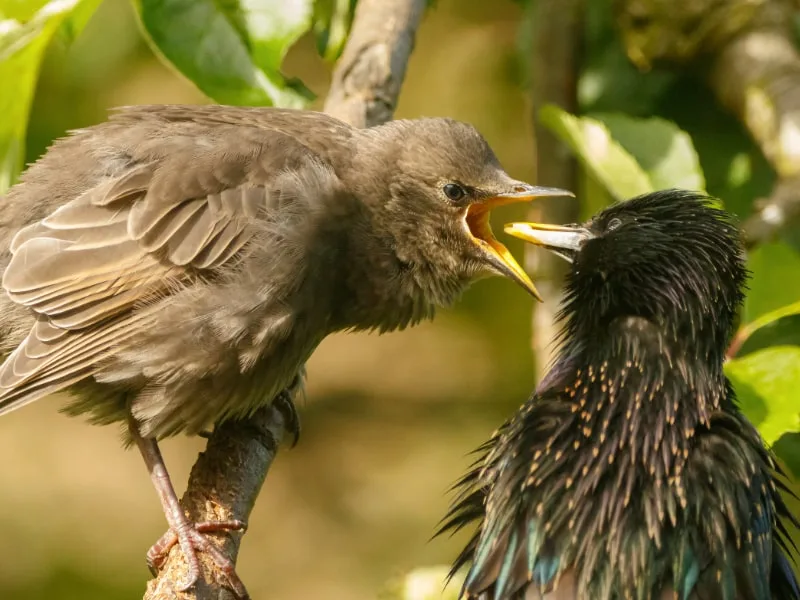
Once fledged, juveniles are still fed by parents for another one to two weeks. Juveniles typically undergo their first molt within two months and gain adult plumage the following year. While starlings are not known for cooperative breeding, rare observations suggest that in some cases, juveniles from a first brood may assist in feeding a second, potentially as an adaptive response to environmental pressures.
Lifespan
In the wild, common starlings typically live around 2 to 3 years. While many individuals die early, especially in their first year, adults that survive past this threshold often live longer, with annual survival rates of around 60%. The oldest known wild individual in North America was a banded male that reached at least 15 years and 3 months. Globally, the verified longevity record is 22 years and 11 months.
Mortality factors
Mortality in starlings is shaped by a range of ecological and behavioral factors. The first autumn and winter are especially dangerous for juveniles, with only about 20% of fledglings surviving to breeding age. Drowning is a surprisingly recurrent cause of death, particularly among inexperienced juveniles during spring and early summer. Mass incidents involving dozens of birds have been reported, often linked to their social behavior and poor hazard recognition.
Intraspecific violence also contributes: in dense breeding colonies, fatal same-sex fights can occur, sometimes resulting in skull punctures from clawing through the eye sockets. Predation, especially by domestic cats during the breeding season, further raises risk.

Notably, first-year females experience higher mortality than males, likely due to the costs of early reproduction. Long-term studies have also shown that individuals with greater telomere attrition during development (an indicator of faster biological aging) tend to exhibit more cautious behavior as adults, suggesting deeper links between early-life stress, survival, and life-history strategy.
Diet
The common starling is a highly opportunistic omnivore with a diet that varies by season, habitat, and life stage. Invertebrates dominate during the breeding season, especially for nestling provisioning, with a strong preference for soft-bodied prey such as Tipulidae (crane fly) larvae, earthworms, and beetle grubs. Adult starlings also consume spiders, ants, dragonflies, moths, and a wide variety of fly larvae.
Outside the breeding season, plant-based foods, including fruits, grains, and seeds, become more important. However, their metabolism limits the efficient digestion of sucrose-rich foods, making them more selective than some frugivores. In island subspecies, such as those from the Azores, starlings have even been observed predating seabird eggs, underscoring their adaptability and dietary flexibility.
Foraging occurs mostly on or just below the ground surface, with a preference for short swards or grazed pastures. Starlings often follow livestock to feed on disturbed insects or even pick parasites directly off their backs. Flocking birds may use a coordinated method known as “roller-feeding,” where individuals take turns moving to the front of the feeding line.
Three principal foraging strategies are observed: “probing,” in which birds insert their bills into soil and expand holes using a gaping motion; “hawking,” the aerial capture of flying insects; and “lunging,” a targeted strike at visible ground prey. The efficiency of these strategies improves with experience, and young starlings often show lower insect intake as they learn.
Laboratory studies support that starlings make flexible, state-dependent decisions based on food availability and time constraints, and field data suggest that optimal patch exploitation often aligns more with family gain models than pure rate maximization. In both wild and captive settings, starlings modulate their foraging effort to regulate body mass daily, gaining weight throughout the day and losing it overnight – a pattern tightly linked to food access and social competition.
Culture
The common starling’s remarkable mimicry has captured human imagination for centuries, earning it a place in mythology, literature, music, and science.
In the medieval Welsh tales of the Mabinogion, a starling is taught to speak and sent across the sea as a messenger. Pliny the Elder described starlings that could recite entire phrases in Latin and Greek, while Shakespeare referenced their ability in Henry IV, imagining one taught to endlessly repeat the name “Mortimer.”
Wolfgang Amadeus Mozart famously kept a pet starling that could whistle a motif from his Piano Concerto No. 17, K. 453 – so accurately that he purchased the bird on the spot. He later gave it a ceremonious funeral, hinting at the emotional bond such vocal birds can inspire.
Starlings are also widely used in behavioral research. They adapt well to captivity, are easy to hand-raise, and thrive in laboratory settings, where their social learning, vocal flexibility, and risk sensitivity have been extensively studied. Konrad Lorenz affectionately called them “the poor man’s dog,” praising their intelligence and social nature.
Recent scientific studies have confirmed that the common starling’s exceptional mimicry is part of a broader cognitive toolkit, placing it among the most intelligent bird species studied to date. Its advanced vocal learning abilities correlate with high problem-solving skills, making it a subject of growing interest in animal cognition research.
Threats and conservation
The common starling is currently classified as Least Concern, supported by its immense range and vast population size. Globally, the number of mature individuals is estimated at approximately 150 million, with Europe accounting for more than half of this total. Including juveniles, the total starling population worldwide likely ranges between 250 and 300 million. In North America, where the species was introduced in the late 19th century, estimates suggest there are over 150 million starlings during the breeding season. While some regional indices suggest long-term declines, particularly in parts of Europe and North America, the species remains one of the most abundant birds in both regions.
Across much of its range, the primary threat to the starling is agricultural intensification. Changes in grassland management, especially reductions in outdoor cattle grazing and the loss of short, intensively grazed pastures, have greatly diminished foraging opportunities during the breeding season. Studies from the UK, Denmark, and Finland show a consistent pattern: local starling populations are positively associated with the availability of grazed grasslands and high densities of cattle. In contrast, regions where livestock has been moved indoors or replaced by autumn-sown arable crops have seen substantial population contractions. Juvenile survival, which depends heavily on abundant soil invertebrates, is especially sensitive to these habitat shifts.
Additional pressures include unregulated hunting and culling, particularly in areas where starlings are considered agricultural pests. Despite their intelligence and adaptability, they are widely disliked for their aggressive competition with native species, crop damage, and large communal roosts. Conservation actions in Europe have included the installation of nestboxes and encouragement of low-intensity farming practices. While no targeted conservation measures exist in North America, the species’ success underscores how flexible generalist species can thrive, or falter, depending on land use patterns. Though still highly abundant, the common starling’s decline in several parts of its range serves as a broader indicator of habitat degradation in farmland ecosystems.
Similar species
Several birds are commonly mistaken for the common starling (Sturnus vulgaris) due to similarities in size, plumage, or behavior. The following species may cause confusion depending on region, season, or age and plumage phase.
Spotless starling (Sturnus unicolor)
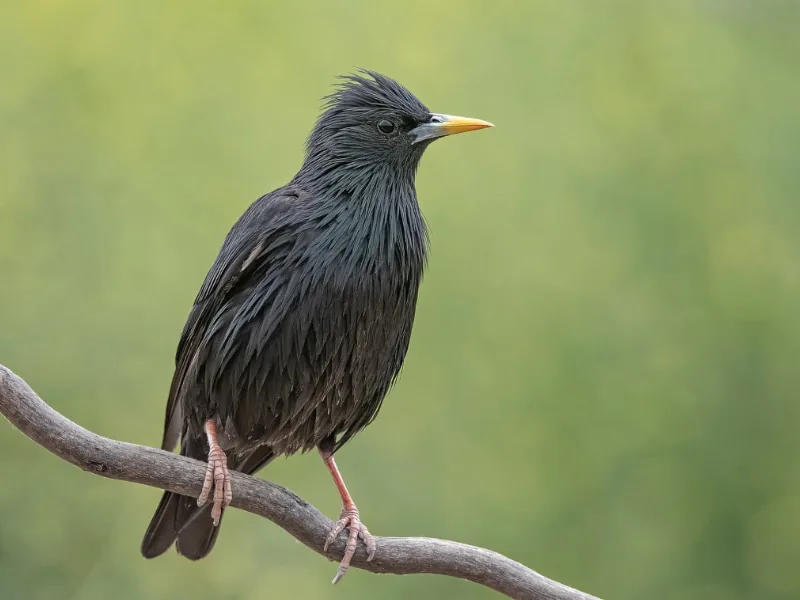
Native to the Iberian Peninsula and North Africa, the spotless starling is a close relative of the common starling. It shares the same shape and glossy dark plumage but lacks the pale speckling in non-breeding plumage that gives S. vulgaris its name. Vocalizations and social behavior are also similar, though the spotless starling’s song is generally more monotonous. Where ranges overlap in southern Europe, the two species can form mixed flocks and hybridize.
Common blackbird (Turdus merula)
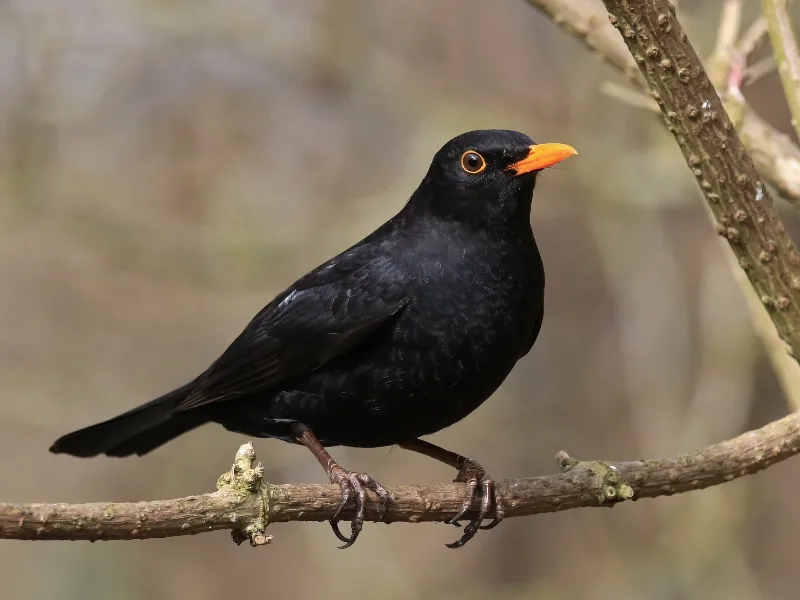
A familiar thrush across Europe and parts of Asia and North Africa, the common blackbird is slightly larger than the starling, with a more upright posture and longer tail. While bulkier in build, its stance can make it appear more elongated and slender. Males are all-black with a bright yellow eye-ring and bill, which contrasts with the starling’s iridescent plumage and short triangular wings. The blackbird’s melodious song and solitary foraging habits also distinguish it from the more gregarious and harsher-voiced starling.
Common grackle (Quiscalus quiscula)

Widespread in eastern and central North America, the common grackle is significantly larger than the starling, with a long keel-shaped tail and a more elongated body. Its iridescent plumage can appear similar in sunlight, but grackles have a heavier bill and a more menacing stare. They often share urban habitats and feeding grounds with starlings, leading to occasional confusion in mixed flocks.
Brewer’s blackbird (Euphagus cyanocephalus)
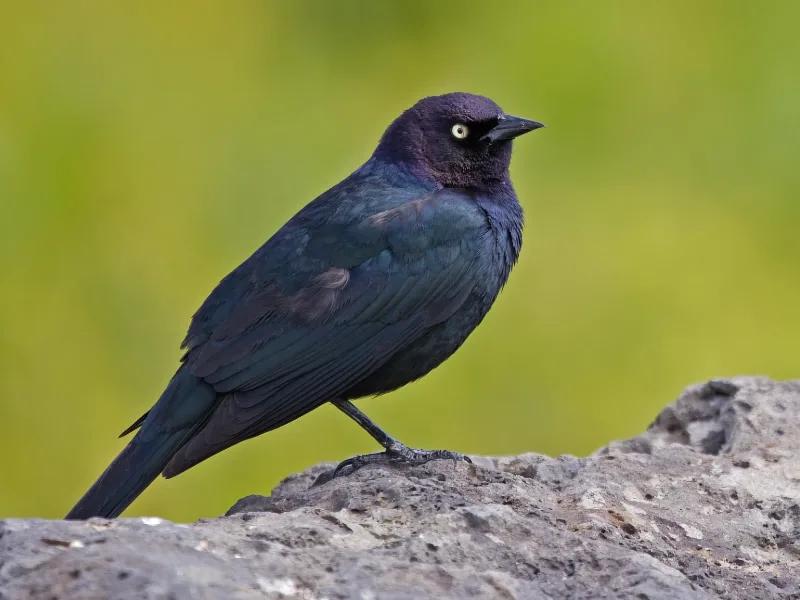
Found across western and central North America, Brewer’s blackbird is similar in size to the starling and also sports a glossy dark appearance in males. However, it has a more slender build, pale eyes, and lacks the short tail and speckled plumage typical of non-breeding starlings. Females are brown and easily distinguished. Unlike starlings, they are less aggressive and form looser flocks.
Brown-headed cowbird (Molothrus ater)
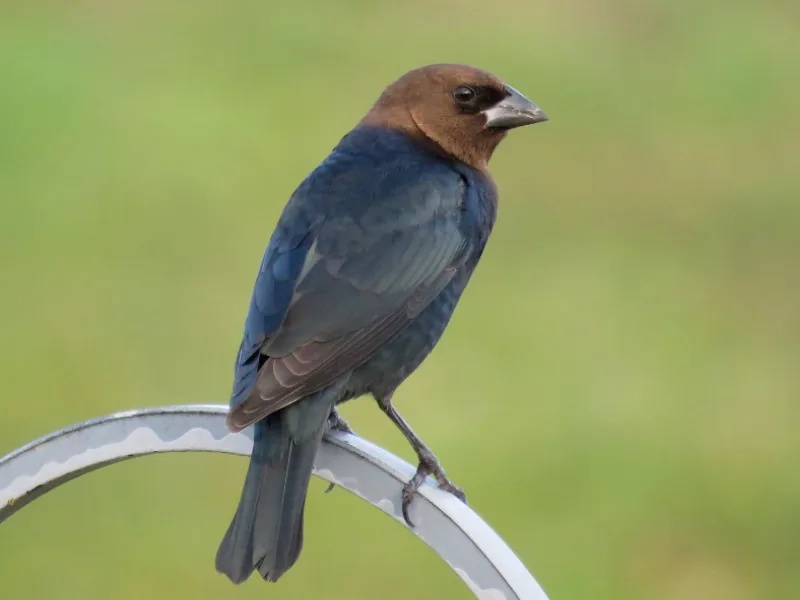
Another North American species often seen alongside starlings, the brown-headed cowbird is slightly smaller and shorter-billed. Males have a distinctive satin-black body with a rich brown head, while females are drab brown overall. They often join mixed-species flocks, particularly in winter, and may be mistaken for juvenile or female starlings at a distance. Unlike starlings, cowbirds are brood parasites and do not build nests.
Future outlook
Despite its abundance, the future of the common starling is not without uncertainty. Long-term monitoring across both its native and introduced ranges reveals divergent trends: while populations remain large overall, significant regional declines, particularly in parts of Europe and North America, highlight vulnerabilities tied to modern agricultural practices.
The loss of traditional grazing systems, conversion of pasture to intensive crop monocultures, and reduced access to soil invertebrates all contribute to diminishing starling numbers in areas once considered strongholds.
At the same time, the species continues to thrive in urban and suburban landscapes, showing remarkable behavioral flexibility and adaptation to human-modified habitats. In North America, where starlings remain one of the continent’s most numerous birds, populations appear more stable, though subject to fluctuations and localized control efforts.
With its intelligence, generalist diet, and ability to exploit novel environments, the common starling is likely to persist in the near future. However, its fortunes, especially in Europe, may increasingly depend on the direction of agricultural and land-use policy, as well as public perception of its ecological role.
